The railroads were the dominant form of transportation
in the United States up through World War II. Most railroads were large
companies that required huge amounts of equipment and material to
operate. Today, collectors of railroadiana actively seek the objects
that made them run.
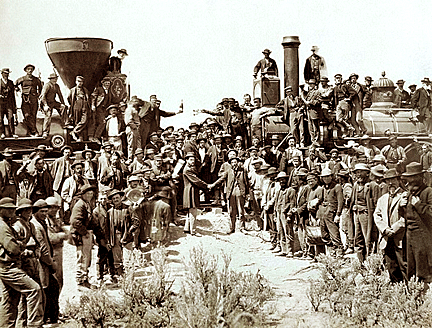
Railroadiana collectors often focus on items from a specific region or
railroad, such as the New York Central, Southern Pacific, Baltimore and
Ohio, Pennsylvania Central, Santa Fe, Norfolk and Western, and Denver
and Rio Grande, or on a specific type of item, such as lanterns or
china.
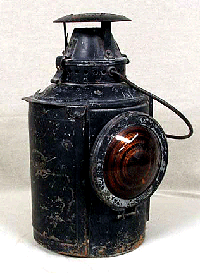 The
different types of collectibles range from lanterns to signs, china to
silver and hollowware, calendars to postcards, posters, photos, and
passes, badges, and pocket watches. Some collectors also base their
collections on items like baggage tags, bells, builders plates, buttons,
marbles, spittoons, uniforms, ashtrays, and railroad-related postal and
telegraph items.
The
different types of collectibles range from lanterns to signs, china to
silver and hollowware, calendars to postcards, posters, photos, and
passes, badges, and pocket watches. Some collectors also base their
collections on items like baggage tags, bells, builders plates, buttons,
marbles, spittoons, uniforms, ashtrays, and railroad-related postal and
telegraph items.
Although many railroad-related items can be bought inexpensively, some
rare pieces command large prices.
Dining car collectibles include silverplated hollowware and flatware
referred to as railroad silver, chinaware, glassware, linens such as
tablecloths, towels and napkins and various other pieces marked with a
railroad company`s logo, name, initials or slogan.
Sleeping car wool blankets marked with a railroad`s name or logo sell
for $65 to $150, hand towels for $10 to $25, pillowcases for $4 to $10
each, headrest covers, $6 to about $12, and sheets, $10 and up.
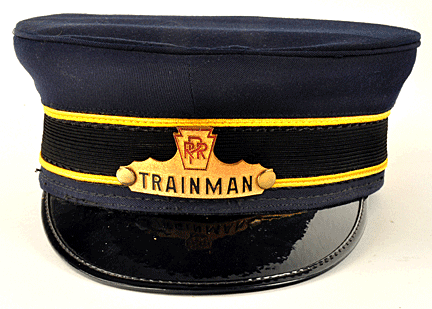 Trainmen`s
caps with metal badges intact are valued from $35 to $175. Cap badges,
minus the caps, have various values, and examples can be found, along
with other types of railroad-related memorabilia.
Trainmen`s
caps with metal badges intact are valued from $35 to $175. Cap badges,
minus the caps, have various values, and examples can be found, along
with other types of railroad-related memorabilia.
Any item, no matter what its age, marked with a railroad`s name, logo or
initials has some value, even ballpoint pens, pencils and scratch pads.
Back in the glory days of over-the-rails passenger transportation,
railroad companies strove to create an atmosphere of luxury aboard their
trains. A critical part of making travelers’ experiences splendidly
upscale was providing actual chinaware on dining car tables and depot
restaurants. The term “railroad china” is incorrectly used by many
people as a generic term for heavyweight, commercial dinnerware,
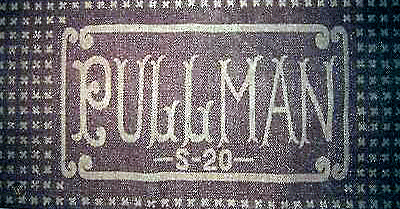 Because
of the “romance of the rails” mystique captivating the public, railway
relics for many years have enjoyed higher prices than similar but
non-transportation items. Novice collectors must learn to recognize not
only non-railroad sellers who unwittingly overprice their items, but
also dishonest scammer sellers deliberately trying to profit by selling
fakes and phonies. To avoid these pitfalls, start slowly but try to
learn fast. Buy what you appeals to you that would keep – do not buy
hoping for a fast turnover and big profit.
Because
of the “romance of the rails” mystique captivating the public, railway
relics for many years have enjoyed higher prices than similar but
non-transportation items. Novice collectors must learn to recognize not
only non-railroad sellers who unwittingly overprice their items, but
also dishonest scammer sellers deliberately trying to profit by selling
fakes and phonies. To avoid these pitfalls, start slowly but try to
learn fast. Buy what you appeals to you that would keep – do not buy
hoping for a fast turnover and big profit.
Collectors collect anything and everything that railroad related, or any
type of piece but only from only one or two railroads. Some focus on one
type of piece such as small pitchers, cup and saucer sets or plates or
build on a color theme.
Railroad China
Railroad decided to pamper their riders by improving the dining
experience. One way they did this was through the use of very fancy
china in their dining cars.
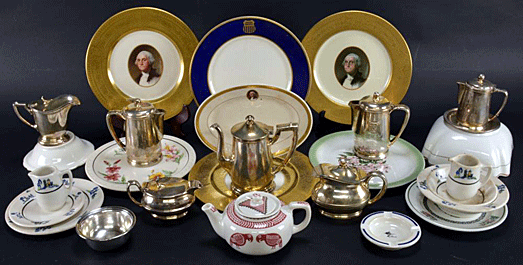
Railroad china, like railroad silver, was a product of the boom in
comfort offered to train passengers in the last part of the 19th century
and first part of the 20th. Collectible railroad china is different than
railroad silver, however, in that china designs are often specific to a
single railroad company—stamps and markings are generally the only
differentiators for silver.
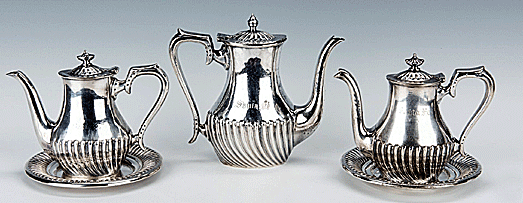
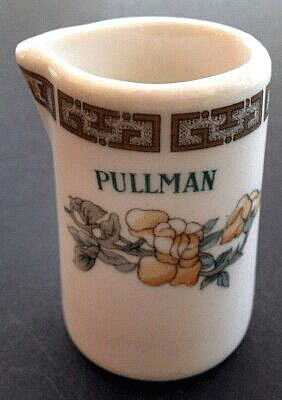 Early
train trips were endurance tests for passengers. Travelers were
subjected to long journeys without proper restrooms or eating and
sleeping facilities. Prior to George Pullman’s decision in the late
1860s to refurbish train cars and turn them into the Ritz Carltons of
transportation, food service happened at train depots.
Early
train trips were endurance tests for passengers. Travelers were
subjected to long journeys without proper restrooms or eating and
sleeping facilities. Prior to George Pullman’s decision in the late
1860s to refurbish train cars and turn them into the Ritz Carltons of
transportation, food service happened at train depots.
Some railroad companies used production china that could be bought
anywhere and simply had their logos stamped on them—such pieces are less
collectible today. Most of the better railroads had custom china
patterns and styles made for their dining cars. These pieces often
depict scenes along the particular route the train ran on—desert scenes
for the Santa Fe, etc. Such custom pieces are especially popular with
railroadiana collectors.
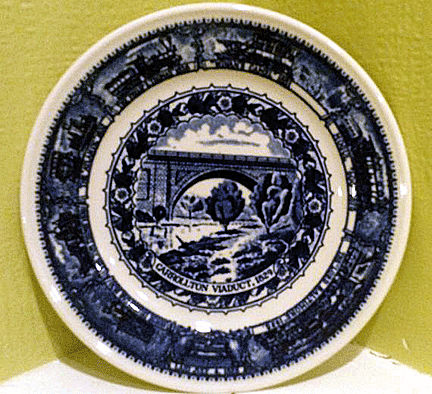 Condition
is critical in railroad china. Damage and flaws make a huge difference
in value. If a piece is extremely rare, somewhat less than perfect can
be tolerable, but damage on a low end piece can make it worthless. That
said, surface marks from utensils documents actual use by railroad
passengers. Minimal scratching is acceptable, but it should not be so
heavy as to have worn off the glaze.
Condition
is critical in railroad china. Damage and flaws make a huge difference
in value. If a piece is extremely rare, somewhat less than perfect can
be tolerable, but damage on a low end piece can make it worthless. That
said, surface marks from utensils documents actual use by railroad
passengers. Minimal scratching is acceptable, but it should not be so
heavy as to have worn off the glaze.
Another complication is that railroad china was so varied. Many patterns
are easy to spot, custom made with names and logos in the decoration.
Others are what is called “Exclusive patterns” with no railway markings,
but a unique design that the china company made and sold ONLY to its
railroad customer. And sometimes railroads purchased “Stock patterns,”
ready made ware available for any customer to buy.
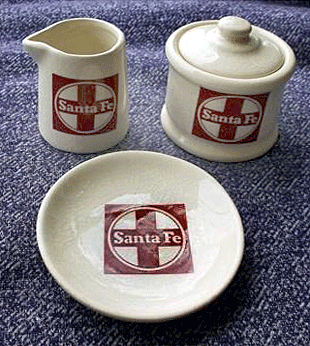 China
is often collected in sets, from plates and cups to ashtrays and
compotes. Completing a set can be difficult because there are often many
different sizes and slight variations to each item.
China
is often collected in sets, from plates and cups to ashtrays and
compotes. Completing a set can be difficult because there are often many
different sizes and slight variations to each item.
Probably the most memorable set of railroad china is the Baltimore &
Ohio (B & O) Railroad’s blue china made in 1927 to celebrate its
hundredth year. Scammell China Company made the set, though the Buffalo
Pottery Company put out a trial set which is tough to find. The pieces
show historical scenes of the train route from the previous 100 years in
the center, with a blue border on the larger pieces showing variations
of the B & O trains through the years. Although this style china is
still being manufactured today, early examples are very rare and sought
after.
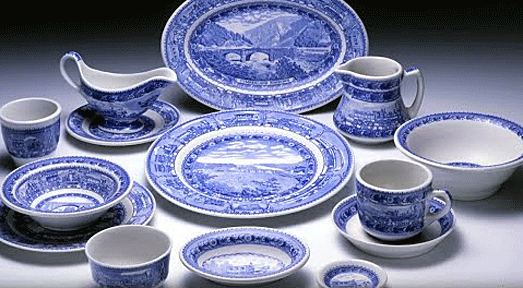
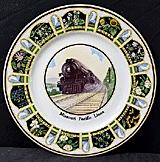 Not
to be outdone, the Chesapeake and Ohio (C & O) Railroad commissioned the
Buffalo Pottery Company in 1932 to make china with a gold rim and a
reproduction of Gilbert Stuart’s portrait “Athenaeum” of George
Washington in the center. The dinnerware was intended to celebrate the
200-year anniversary of the first President’s birth.
Not
to be outdone, the Chesapeake and Ohio (C & O) Railroad commissioned the
Buffalo Pottery Company in 1932 to make china with a gold rim and a
reproduction of Gilbert Stuart’s portrait “Athenaeum” of George
Washington in the center. The dinnerware was intended to celebrate the
200-year anniversary of the first President’s birth.
Other collectible patterns include Missouri Pacific’s State Flower
series, which depicted the flowers from each of the states that the
train line ran through. Later, in 1948, Missouri Pacific changed over to
the State Capitol pattern, which it produced it until 1961. The
Milwaukee Road had sets of china with birds in various shades of pink.
Most rail companies copyrighted their proprietary designs. Union Pacific
had its Herriman Blue, The Great Northern had Mountains and Flowers, the
Pullman Company had Indian Tree, and, as you might expect, the Oriental
Limited had an Asian-themed design. Look for railroad china with either
a stamp on the back indicating which company it was made for, or a
railroad’s insignia on the front. China without these marking are less
collectible because the possibility exists that they were used for
something other than railroads, like hotels.
< Back to Collecting Archives
Next Article >
